Optimal and Sustainable Scheduling of Integrated Energy System Coupled with CCS-P2G and Waste-to-Energy Under the “Green-Carbon” Offset Mechanism
Abstract
1. Introduction
- (1)
- There are few studies on the combination of WTE and IES. How should the optimal scheduling of the WTE-IES be carried out?
- (2)
- Considering the market mechanism and low-carbon measures, when CCS-P2G is applied to the WTE-IES coupling system, enabling it to utilize the CO2 generated from waste incineration, what are the specific effects?
- (3)
- How to design an effective ladder-type CET-GCT offset mechanism, and at the same time, make it improve the low-carbon economic efficiency of the WTE-IES coupling system incorporating CCS-P2G?
- (1)
- An IES-WTE hybrid system is developed, incorporating CHP, CCS, P2G, photovoltaic (PV), wind turbine (WT), and multiple energy storage technologies. This system is designed for optimal municipal solid waste utilization amid increasing urban waste generation.
- (2)
- A multi-energy system model incorporating CCS and two-stage P2G is established, where the optimal solution is obtained under given parameters and capacity constraints while considering the time-varying characteristics of energy prices, thereby enhancing the renewable energy utilization efficiency of the IES-WTE coupled system. The simulation results show that, compared with Case 2, the carbon emissions in Case 3 are reduced by approximately 17.25%.
- (3)
- A ladder-type “green-carbon” offset mechanism is proposed, enabling TGC-to-carbon emission rights conversion. Effective coordination between CCS-P2G and ladder-type CET-GCT offset mechanisms is achieved. This approach significantly improves both economic performance and low-carbon characteristics of the IES. Sensitivity analysis is conducted on the proposed ladder-type “green-carbon” offset mechanism. After the introduction of ladder-type CET-GCT offset mechanisms, the total cost of Case 6 has decreased by approximately 33.5% compared with that of Case 3.
2. Modeling of IES
2.1. Basic Structure of IES
2.2. Equipment Mathematical Model
2.2.1. The Modeling of CCS with Liquid Storage Tanks
2.2.2. P2G Modeling
2.2.3. WTE Power Plant Modeling
2.2.4. CHP and GB Modeling
2.2.5. The Various Energy Storage Devices Modeling
2.3. Ladder-Type “Green-Carbon” Offset Mechanism
2.3.1. Ladder-Type CET Mechanism
2.3.2. Ladder-Type GCT Mechanism
2.3.3. Ladder-Type CET-GCT Mechanism
3. IES Low-Carbon Economic Dispatch Model
3.1. Objective Function
- (1)
- Carbon sequestration cost
- (2)
- Operating cost of the WTE power plant
- (3)
- Energy purchase cost
- (4)
- Curtailed WT and PV cost
- (5)
- Equipment operation and maintenance cost
3.2. Constraints
- Power balance constraint
- 2.
- WT and PV power supply constraints
- 3.
- CHP unit ramp rate and output constraints
- 4.
- GB ramp rate and output constraints
- 5.
- WTE generator set constraints
- 6.
- CCS constraints
- 7.
- Multi-type energy storage constraints
- 8.
- P2G energy consumption upper and lower limits constraints
3.3. Model Transformation
4. Case Analysis
4.1. Case Conditions
4.2. Analysis of the Optimal Scheduling Results for Typical Daily Scenarios
4.3. Economic Benefit Analysis of IES
4.4. Analysis of IES Scheduling Results
4.5. Sensitivity Analysis of the ”Green-Carbon” Offset Mechanism
5. Conclusions
- (1)
- Compared with considering P2G alone or CCS-P2G collaborative operation, the flexible operation mode with decoupled two-stage P2G achieves the highest consumption of WT and PV—the consumption rate of wind and solar energy is 97.25%; the lowest system operation cost—the total cost is CNY 127,987.9559; and the lowest carbon emission level—the carbon emissions are 73,446.2553 kg.
- (2)
- The sensitivity analysis of the reward–penalty ladder-type CET further indicates that under the flexible operation mode of CCS and P2G, WT and PV consumption is maximized, and hydrogen storage plays a significant role in consuming renewable energy.
- (3)
- After introducing the ladder-type GCT, the system cost is further reduced. However, since the WT and PV rates have reached a relatively high value, the promotion effect on renewable energy is not obvious.
- (4)
- With the introduction of the GCT offset mechanism, both the system cost and carbon emissions are significantly reduced. Specifically, compared with Case 5 without the introduction of the offset mechanism, the total cost of Case 6 with the introduction of the offset mechanism decreased by approximately 12.71%, and the carbon emissions were reduced by approximately 64.59%. Meanwhile, profits are successfully achieved by selling carbon emission allowances.
6. Discussion
- (1)
- The optimal scheduling model of WTE-IES, which combines CCS-P2G with the ladder-type CET-GCT constructed in this paper, does not take into account the thermal and gas inertia during the optimal scheduling of the IES. In the next step, the impact of thermal and gas inertia on the optimal scheduling of the IES will be investigated.
- (2)
- The model constructed in this paper assumes that the CO2 emission coefficient; the dynamic energy consumption of CCS; the cost of sequestering a unit mass of CO2; the efficiencies of the electrolyzer, methanation, etc. are fixed; and the liquid storage equipment follows a linear model. However, in actual industrial production, these factors may vary. Therefore, we will discuss them in future research.
- (3)
- The research did not take into account the uncertainties of the load, as well as the WT and PV. Therefore, in subsequent research, uncertain prediction methods such as robustness will be attempted to be incorporated.
Author Contributions
Funding
Institutional Review Board Statement
Informed Consent Statement
Data Availability Statement
Conflicts of Interest
References
- Zhao, X.; Jiang, G.; Li, A.; Wang, L. Economic Analysis of Waste-to-Energy Industry in China. Waste Manag. 2016, 48, 604–618. [Google Scholar] [CrossRef] [PubMed]
- Sajid Khan, M.; Huan, Q.; Lin, J.; Zheng, R.; Gao, Z.; Yan, M. Exergoeconomic Analysis and Optimization of an Innovative Municipal Solid Waste to Energy Plant Integrated with Solar Thermal System. Energy Convers. Manag. 2022, 258, 115506. [Google Scholar] [CrossRef]
- Khan, M.S.; Huan, Q.; Yan, M.; Ali, M.; Noor, O.U.; Abid, M. A Novel Configuration of Solar Integrated Waste-to-Energy Incineration Plant for Multi-Generational Purpose: An Effort for Achieving Maximum Performance. Renew. Energy 2022, 194, 604–620. [Google Scholar] [CrossRef]
- Chen, H.; Zhang, M.; Xue, K.; Xu, G.; Yang, Y.; Wang, Z.; Liu, W.; Liu, T. An Innovative Waste-to-Energy System Integrated with a Coal-Fired Power Plant. Energy 2020, 194, 116893. [Google Scholar] [CrossRef]
- Pan, P.; Zhang, M.; Xu, G.; Chen, H.; Song, X.; Liu, T. Thermodynamic and Economic Analyses of a New Waste-to-Energy System Incorporated with a Biomass-Fired Power Plant. Energies 2020, 13, 4345. [Google Scholar] [CrossRef]
- Pan, M.; Chen, X.; Li, X. Multi-Objective Analysis and Optimization of Cascade Supercritical CO2 Cycle and Organic Rankine Cycle Systems for Waste-to-Energy Power Plant. Appl. Therm. Eng. 2022, 214, 118882. [Google Scholar] [CrossRef]
- Chen, S.C.; Dang, X.; Xu, Q.; Own, C.-M. Transforming Waste into Value: Sustainable Recycling of Agricultural Resources Under the ‘Carbon Peak and Carbon Neutrality’ Vision. Sustainability 2025, 17, 55. [Google Scholar] [CrossRef]
- Armoo, E.A.; Narra, S.; Mohammed, M.; Boahemaa, B.; Beguedou, E.; Kemausuor, F.; Agyenim, F.B. Hybrid Waste-to-Energy Solutions within a Circular Economy Framework Directed towards Sustainable Urban Waste Management in Ghana. Sustainability 2024, 16, 4976. [Google Scholar] [CrossRef]
- Roa, I.D.; Henriquez, J.R.; Dutra, E.D.; Menezes, R.S.C.; Andrade, M.M.M.; Santos Junior, E.P.; Rocha, L.C.S.; Rotella Junior, P. Economic Feasibility of Biogas Microgeneration from Food Waste: Potential for Sustainable Energy in Northeastern Brazil. Sustainability 2024, 16, 10238. [Google Scholar] [CrossRef]
- Ćurčić, S.; Milićević, D.; Kilibarda, N.; Peulić, A. Assessing Biogas Production Potential from Organic Waste and Livestock Byproducts in a Serbian Municipality: Implications for Sustainable Food Systems. Sustainability 2025, 17, 3144. [Google Scholar] [CrossRef]
- Wijesekara, D.; Amarasinghe, P.; Induranga, A.; Vithanage, V.; Koswattage, K.R. Energy, Exergy, and Environmental Impact Analysis and Optimization of Coal–Biomass Combustion Combined Cycle CHP Systems. Sustainability 2025, 17, 2363. [Google Scholar] [CrossRef]
- Li, X.; Zhang, R.; Bai, L.; Li, G.; Jiang, T.; Chen, H. Stochastic Low-Carbon Scheduling with Carbon Capture Power Plants and Coupon-Based Demand Response. Appl. Energy 2018, 210, 1219–1228. [Google Scholar] [CrossRef]
- Lei, D.; Zhang, Z.; Wang, Z.; Zhang, L.; Liao, W. Long-Term, Multi-Stage Low-Carbon Planning Model of Electricity-Gas-Heat Integrated Energy System Considering Ladder-Type Carbon Trading Mechanism and CCS. Energy 2023, 280, 128113. [Google Scholar] [CrossRef]
- Ding, X.; Yang, Z.; Zheng, X.; Zhang, H.; Sun, W. Effect of Decision-Making Principle on P2G–CCS–CHP Complementary Energy System Based on IGDT Considering Energy Uncertainty. Int. J. Hydrogen Energy 2024, 81, 986–1002. [Google Scholar] [CrossRef]
- Zhang, Y.; Sun, P.; Ji, X.; Yang, M.; Ye, P. Low-Carbon Economic Dispatch of Integrated Energy Systems Considering Full-Process Carbon Emission Tracking and Low Carbon Demand Response. IEEE Trans. Netw. Sci. Eng. 2024, 11, 5417–5431. [Google Scholar] [CrossRef]
- Ma, Y.; Wang, H.; Hong, F.; Yang, J.; Chen, Z.; Cui, H.; Feng, J. Modeling and Optimization of Combined Heat and Power with Power-to-Gas and Carbon Capture System in Integrated Energy System. Energy 2021, 236, 121392. [Google Scholar] [CrossRef]
- Li, J.; Ai, Q.; Chen, M. Strategic Behavior Modeling and Energy Management for Electric-Thermal-Carbon-Natural Gas Integrated Energy System Considering Ancillary Service. Energy 2023, 278, 127745. [Google Scholar] [CrossRef]
- Wang, L.; Luo, L.; Yu, M.; Pei, X. Low-Carbon Integrated Energy System Scheduling Considering Electric Vehicle Demand Response. J. Clean. Prod. 2024, 480, 144073. [Google Scholar] [CrossRef]
- Wang, L.; Ren, X.; Ma, Y.; Liu, Z.; Dong, W.; Ni, L. Optimal Low-Carbon Scheduling of Integrated Energy Systems Considering Stepped Carbon Trading and Source-Load Side Resources. Energy Rep. 2024, 12, 3145–3154. [Google Scholar] [CrossRef]
- Huang, Q.; Song, Y.; Sun, Q.; Ren, X.; Wang, W. Integrating Compressed CO2 Energy Storage in an Integrated Energy System. Energies 2024, 17, 1570. [Google Scholar] [CrossRef]
- Mochi, P. Perspective on Challenges and Opportunities in Integrated Electricity-Hydrogen Market. Energy Sustain. Dev. 2025, 87, 101728. [Google Scholar] [CrossRef]
- Su, Y.; Tan, M.; Teh, J. Short-Term Transmission Capacity Prediction of Hybrid Renewable Energy Systems Considering Dynamic Line Rating Based on Data-Driven Model. IEEE Trans. Ind. Appl. 2025, 61, 2410–2420. [Google Scholar] [CrossRef]
- Zhang, S.; Pan, G.; Li, B.; Gu, W.; Fu, J.; Sun, Y. Multi-Timescale Security Evaluation and Regulation of Integrated Electricity and Heating System. IEEE Trans. Smart Grid 2025, 16, 1088–1099. [Google Scholar] [CrossRef]
- Wang, Z.; Wu, J.; Kou, Y.; Zhang, M.; Jiang, H. Collaborative Optimization Scheduling of Source-Network-Load-Storage System Based on Ladder-Type Green Certificate–Carbon Joint Trading Mechanism and Integrated Demand Response. Sustainability 2024, 16, 10104. [Google Scholar] [CrossRef]
- Fan, M.; Liu, L. Portfolio of China’s Renewable Energy Legal Measures: Conflicts in Application and Functional Harmonization. Energy 2025, 320, 135377. [Google Scholar] [CrossRef]
- Hou, H.; Ge, X.; Yan, Y.; Lu, Y.; Zhang, J.; Dong, Z.Y. An Integrated Energy System “Green-Carbon” Offset Mechanism and Optimization Method with Stackelberg Game. Energy 2024, 294, 130617. [Google Scholar] [CrossRef]
- Liu, D.; Luo, Z.; Qin, J.; Wang, H.; Wang, G.; Li, Z.; Zhao, W.; Shen, X. Low-Carbon Dispatch of Multi-District Integrated Energy Systems Considering Carbon Emission Trading and Green Certificate Trading. Renew. Energy 2023, 218, 119312. [Google Scholar] [CrossRef]
- Yan, Q.; Ai, X.; Li, J. Low-Carbon Economic Dispatch Based on a CCPP-P2G Virtual Power Plant Considering Carbon Trading and Green Certificates. Sustainability 2021, 13, 12423. [Google Scholar] [CrossRef]
- Yang, S.; Tan, Z.; Lin, H.; Li, P.; De, G.; Zhou, F.; Ju, L. A Two-Stage Optimization Model for Park Integrated Energy System Operation and Benefit Allocation Considering the Effect of Time-Of-Use Energy Price. Energy 2020, 195, 117013. [Google Scholar] [CrossRef]
- Tan, J.; Pan, W.; Li, Y.; Hu, H.; Zhang, C. Energy-Sharing Operation Strategy of Multi-District Integrated Energy Systems Considering Carbon and Renewable Energy Certificate Trading. Appl. Energy 2023, 339, 120835. [Google Scholar] [CrossRef]
- Zhang, Y.; Wu, Q.; Ren, H.; Li, Q.; Zhou, W. Optimal Operation of Multi-Microgrid Systems Considering Multi-Level Energy-Certificate-Carbon Coupling Trading. Renew. Energy 2024, 227, 120505. [Google Scholar] [CrossRef]
- Zhang, L.; Liu, D.; Cai, G.; Lyu, L.; Koh, L.H.; Wang, T. An Optimal Dispatch Model for Virtual Power Plant That Incorporates Carbon Trading and Green Certificate Trading. Int. J. Electr. Power Energy Syst. 2023, 144, 108558. [Google Scholar] [CrossRef]
- Wang, Y.; Wu, X.; Liu, M.; Zhang, C.; Wang, H.; Yue, Y.; Luo, X. Bidding Strategy of the Virtual Power Plant Considering Green Certificates and Carbon Trading. Energy Rep. 2023, 9, 73–84. [Google Scholar] [CrossRef]
- Guo, Z.; Zhou, S. Modeling and Multi-Stage Planning of Cement-IIES Considering Carbon-Green Certificate Trading. Processes 2023, 11, 1219. [Google Scholar] [CrossRef]
- He, L.; Lu, Z.; Zhang, J.; Geng, L.; Zhao, H.; Li, X. Low-Carbon Economic Dispatch for Electricity and Natural Gas Systems Considering Carbon Capture Systems and Power-to-Gas. Appl. Energy 2018, 224, 357–370. [Google Scholar] [CrossRef]
- Chen, Q.; Kang, C.; Xia, Q. Modeling Flexible Operation Mechanism of CO2 Capture Power Plant and Its Effects on Power-System Operation. IEEE Trans. Energy Convers. 2010, 25, 853–861. [Google Scholar] [CrossRef]
- Cui, Y.; Xu, Y.; Huang, T.; Wang, Y.; Cheng, D.; Zhao, Y. Low-Carbon Economic Dispatch of Integrated Energy Systems That Incorporate CCPP-P2G and PDR Considering Dynamic Carbon Trading Price. J. Clean. Prod. 2023, 423, 138812. [Google Scholar] [CrossRef]
- Haslbeck, J.L.; Kuehn, N.J.; Lewis, E.G.; Pinkerton, L.L.; Simpson, J.; Turner, M.J.; Varghese, E.; Woods, M.C. Cost and Performance Baseline for Fossil Energy Plants. In Bituminous coal and Natural Gas to Electricity; US Department of Energy: Washington, DC, USA, 2010; Volume 1. [Google Scholar]
- Huang, Y.; Liu, W.; Zhang, X.J.; Wang, T.; Fang, M.X.; Gonzalez-Diaz, A.; Jiang, L. Flexibility Analysis on Absorption-Based Carbon Capture Integrated with Energy Storage. Fuel 2024, 372, 132279. [Google Scholar] [CrossRef]
- Baudoux, A.; Demeyer, F.; Paepe, W.D. Advanced Configurations of Amine Based Post-Combustion Carbon Capture Process Applied to Combined Cycle Gas Turbine. Energy Convers. Manag. X 2024, 22, 100537. [Google Scholar] [CrossRef]
- Chen, D.; Liu, F.; Liu, S. Optimization of Virtual Power Plant Scheduling Coupling with P2G-CCS and Doped with Gas Hydrogen Based on Stepped Carbon Trading. dwjs 2022, 46, 2042–2053. [Google Scholar]
- Liu, Y.; Zeng, L.; Zeng, J.; Yang, Z.; Li, N.; Li, Y. Scheduling Optimization of IEHS with Uncertainty of Wind Power and Operation Mode of CCP. Energies 2023, 16, 2157. [Google Scholar] [CrossRef]
- Wang, R.; Wen, X.; Wang, X.; Fu, Y.; Zhang, Y. Low Carbon Optimal Operation of Integrated Energy System Based on Carbon Capture Technology, LCA Carbon Emissions and Ladder-Type Carbon Trading. Appl. Energy 2022, 311, 118664. [Google Scholar] [CrossRef]
- Zhong, J.; Li, Y.; Wu, Y.; Cao, Y.; Li, Z.; Peng, Y.; Qiao, X.; Xu, Y.; Yu, Q.; Yang, X.; et al. Optimal Operation of Energy Hub: An Integrated Model Combined Distributionally Robust Optimization Method with Stackelberg Game. IEEE Trans. Sustain. Energy 2023, 14, 1835–1848. [Google Scholar] [CrossRef]
- Lin, B.; Jia, Z. Impacts of Carbon Price Level in Carbon Emission Trading Market. Appl. Energy 2019, 239, 157–170. [Google Scholar] [CrossRef]
- Li, X.; Deng, J.; Liu, J. Energy–Carbon–Green Certificates Management Strategy for Integrated Energy System Using Carbon–Green Certificates Double-Direction Interaction. Renew. Energy 2025, 238, 121937. [Google Scholar] [CrossRef]
- Xuan, A.; Shen, X.; Guo, Q.; Sun, H. Two-Stage Planning for Electricity-Gas Coupled Integrated Energy System with Carbon Capture, Utilization, and Storage Considering Carbon Tax and Price Uncertainties. IEEE Trans. Power Syst. 2023, 38, 2553–2565. [Google Scholar] [CrossRef]
- Zhong, J.; Zhao, Y.; Li, Y.; Yan, M.; Peng, Y.; Cai, Y.; Cao, Y. Synergistic Operation Framework for the Energy Hub Merging Stochastic Distributionally Robust Chance-Constrained Optimization and Stackelberg Game. IEEE Trans. Smart Grid 2025, 16, 1037–1050. [Google Scholar] [CrossRef]
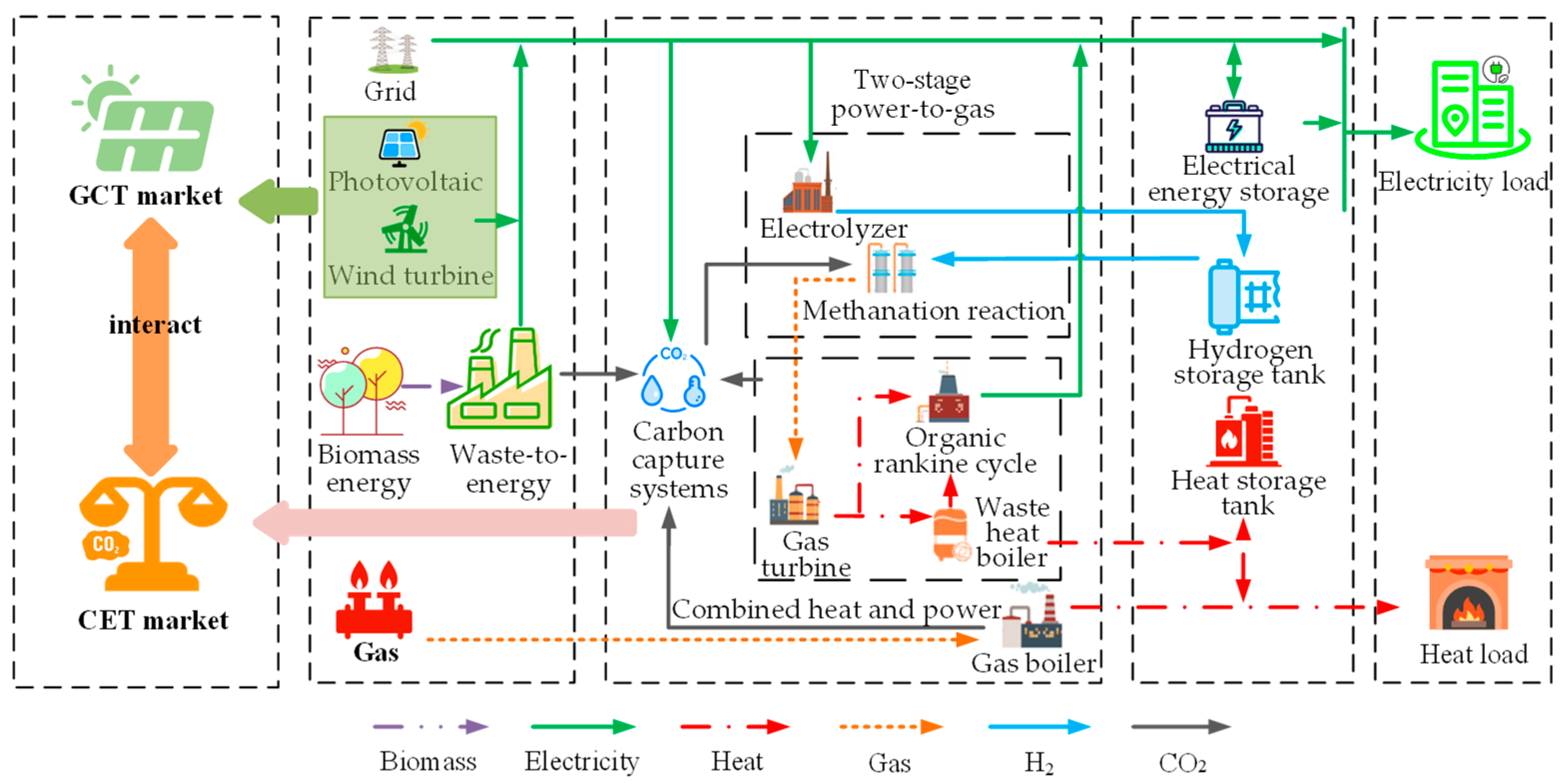
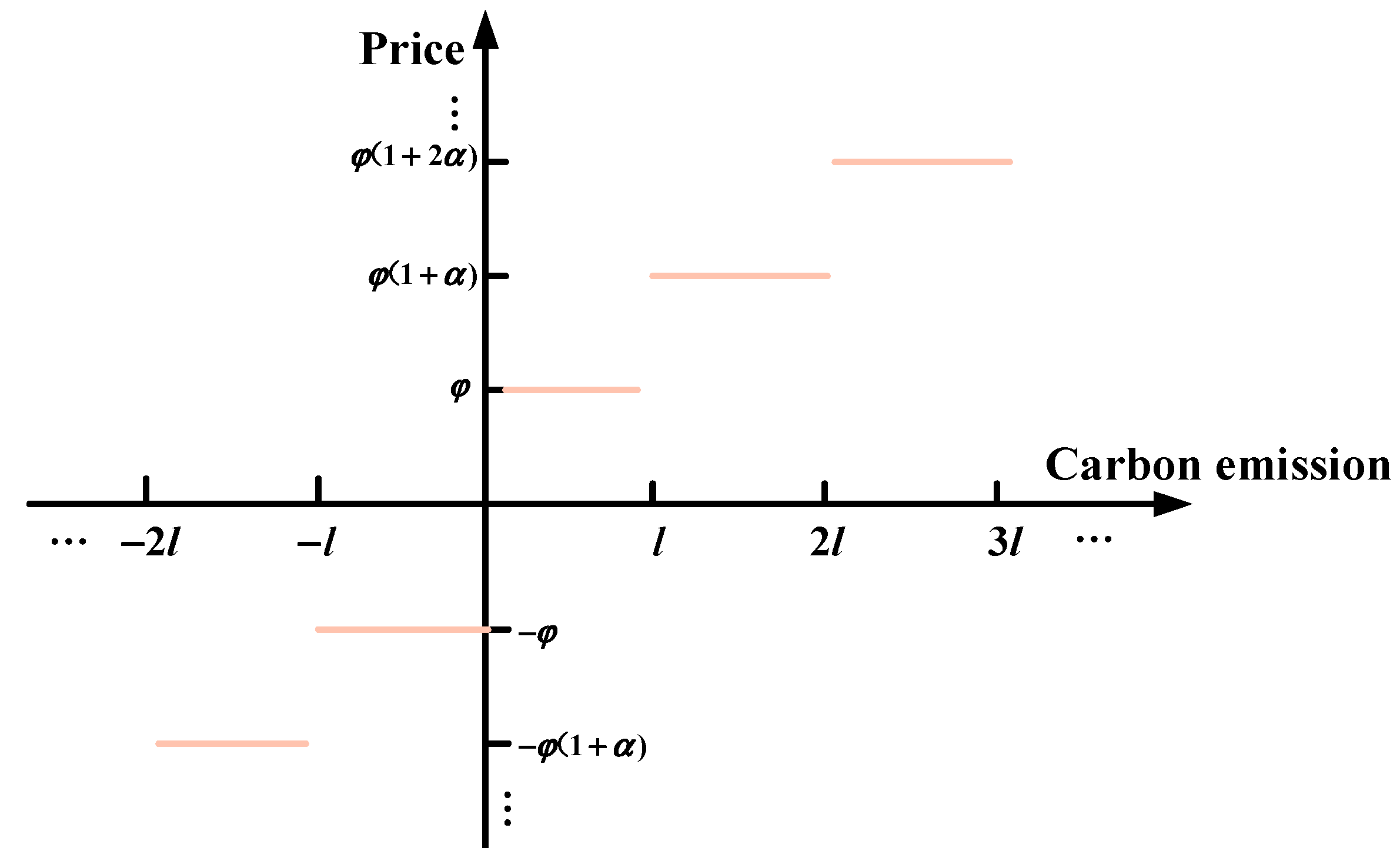
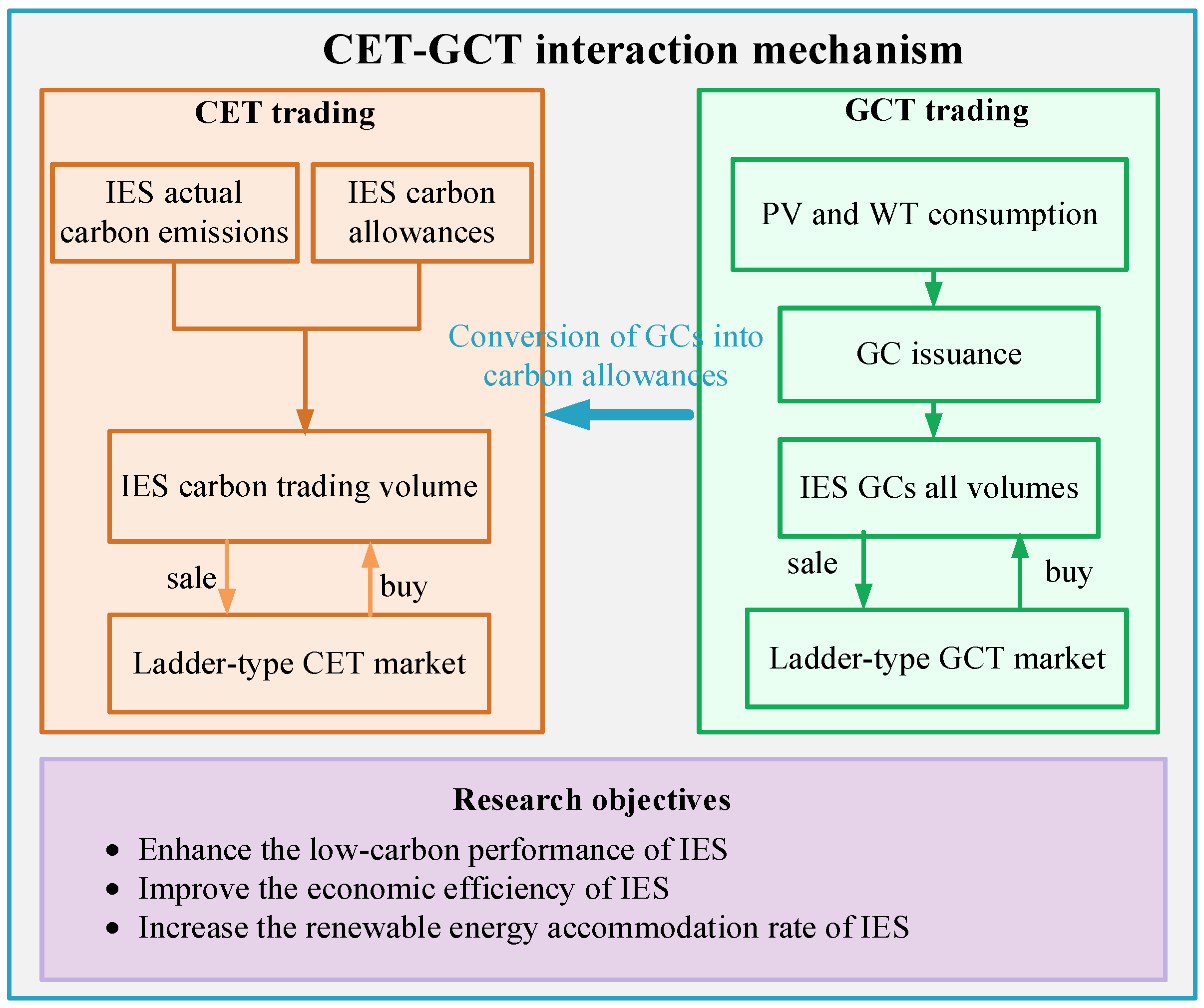
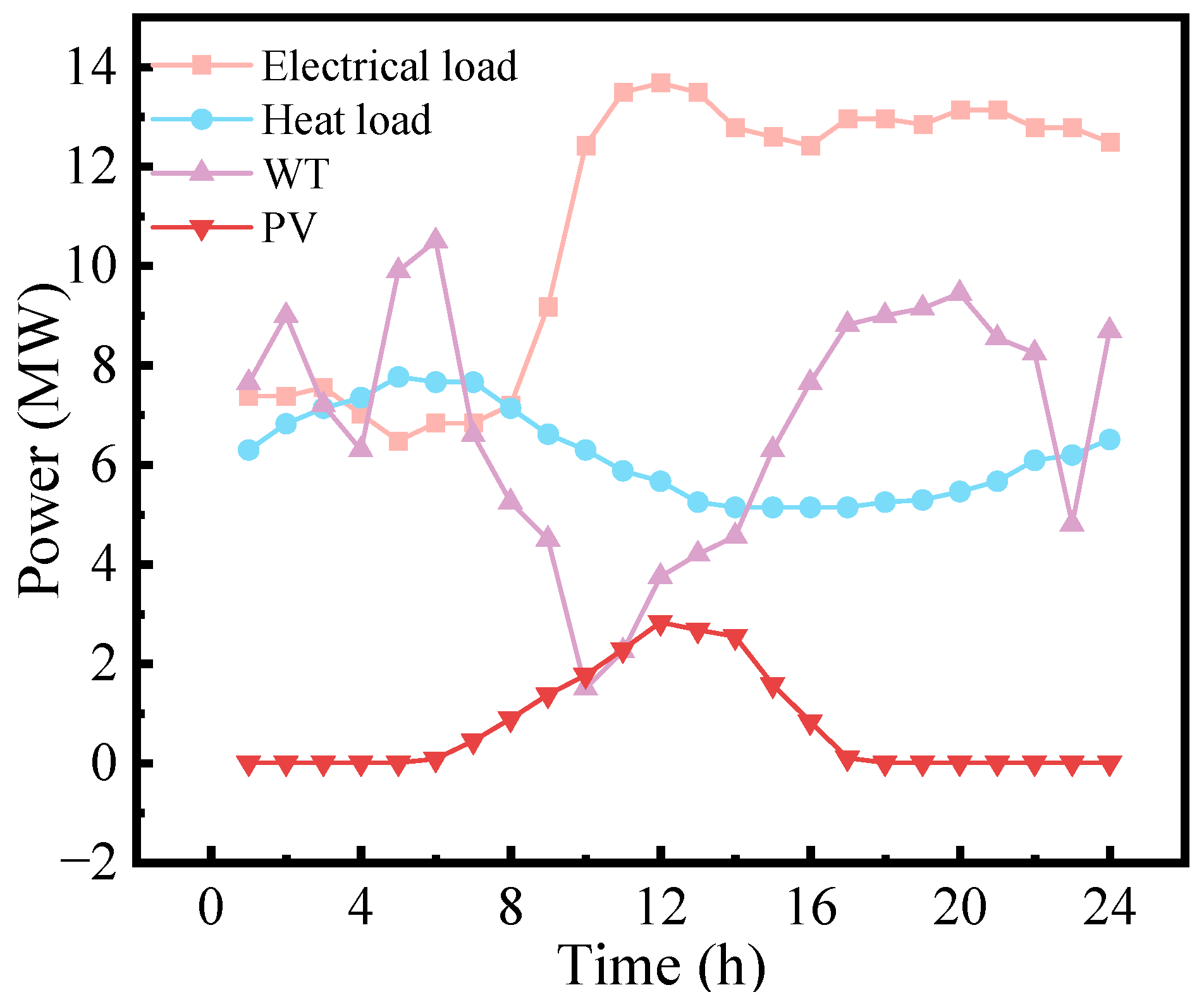

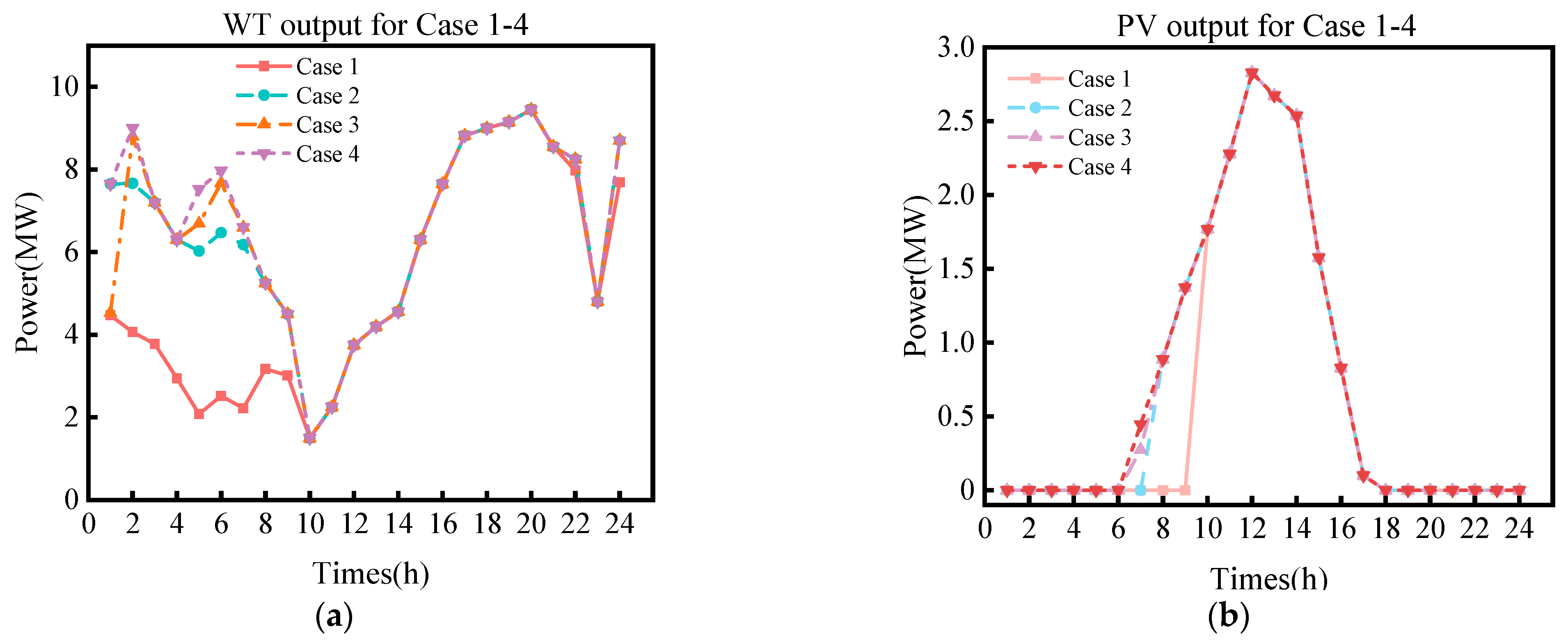

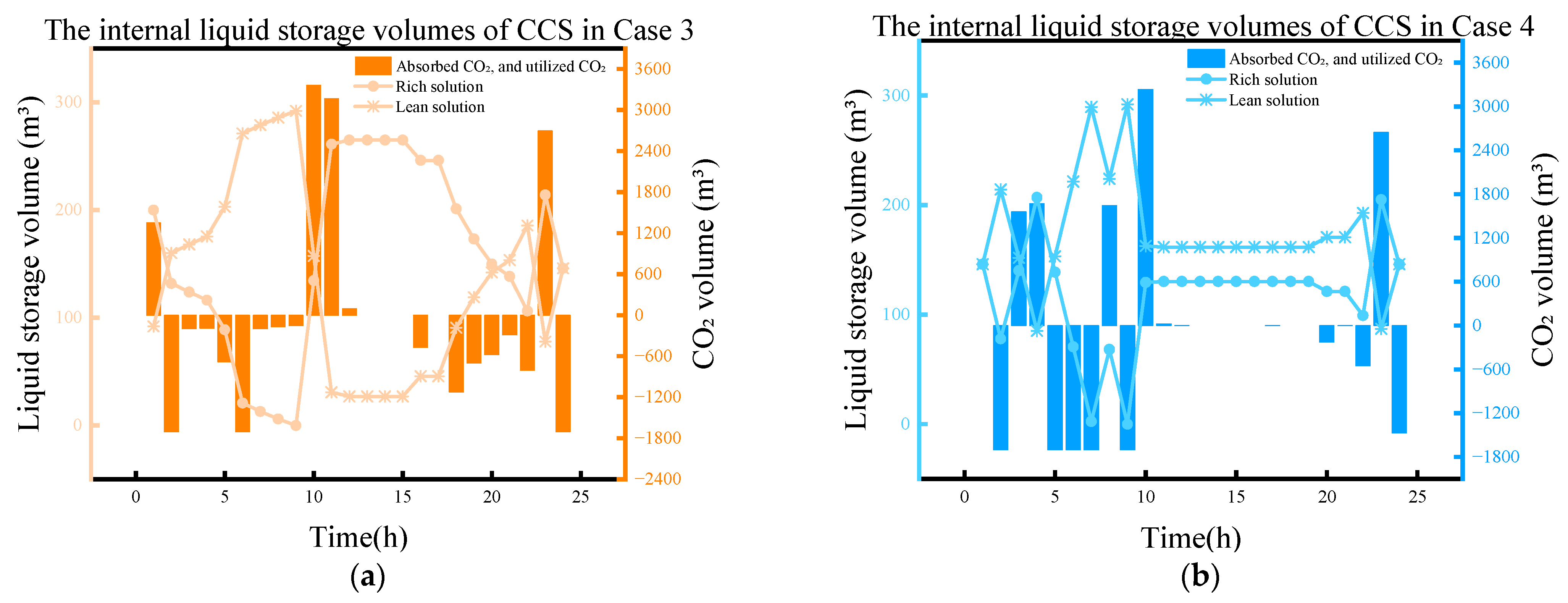
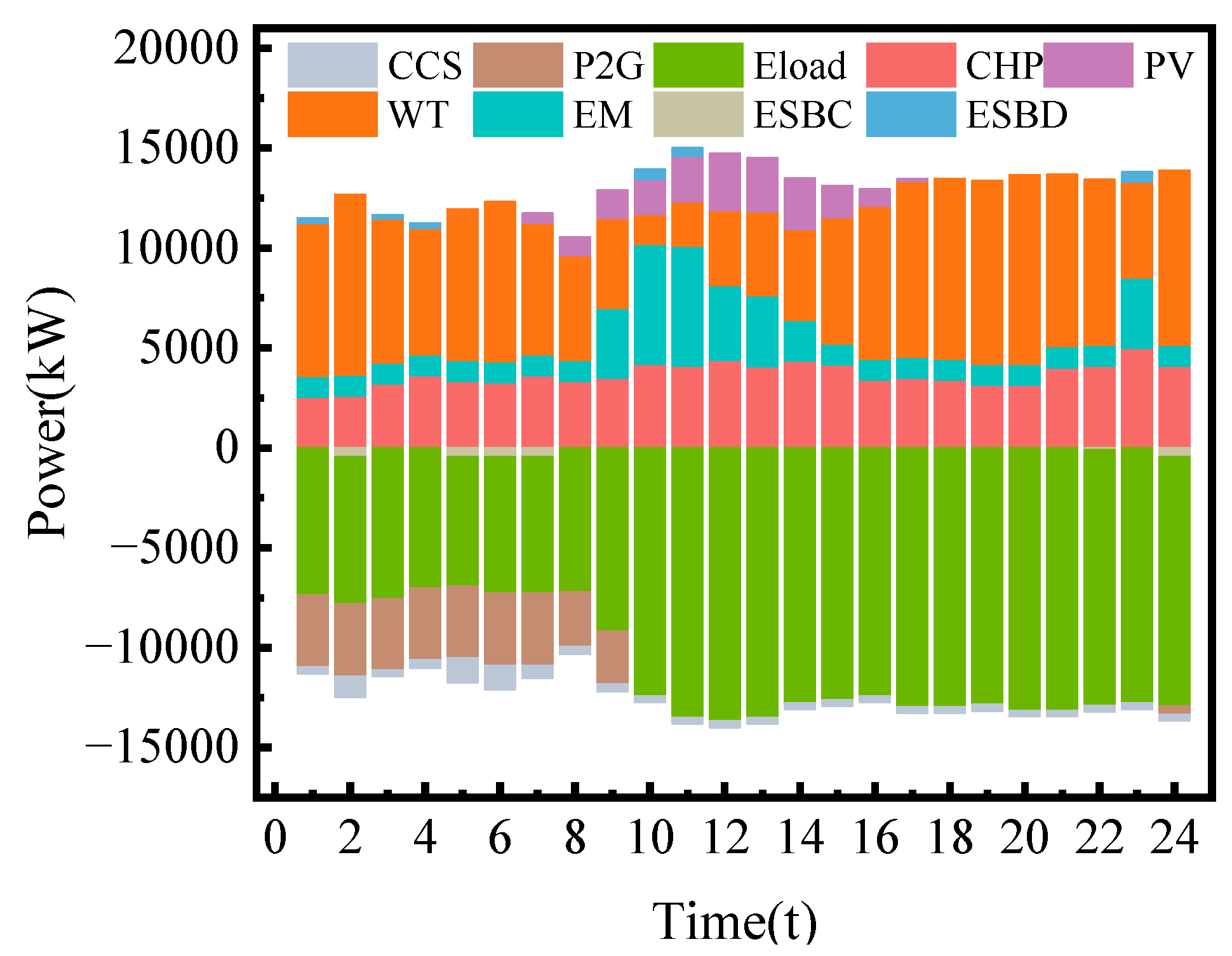

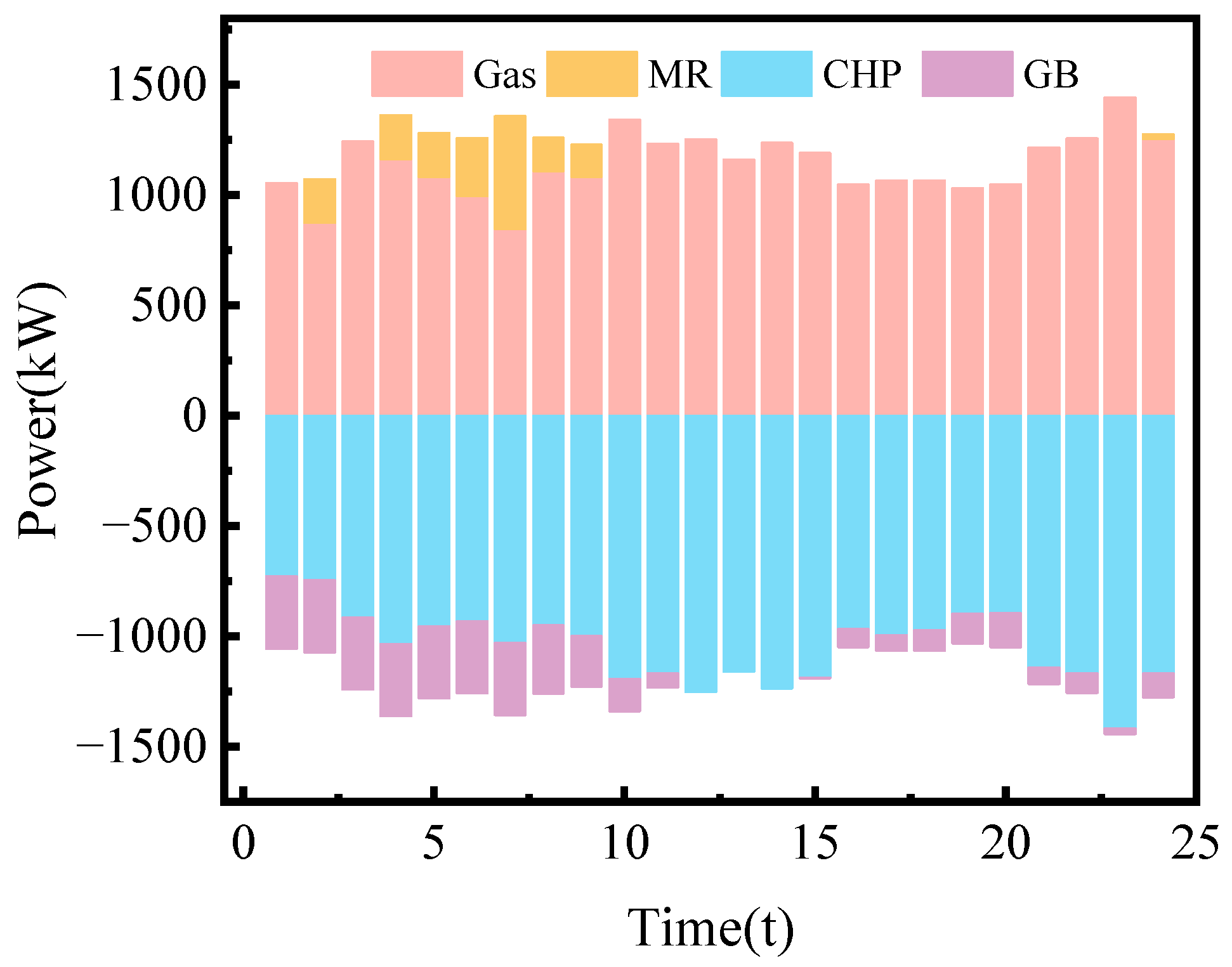
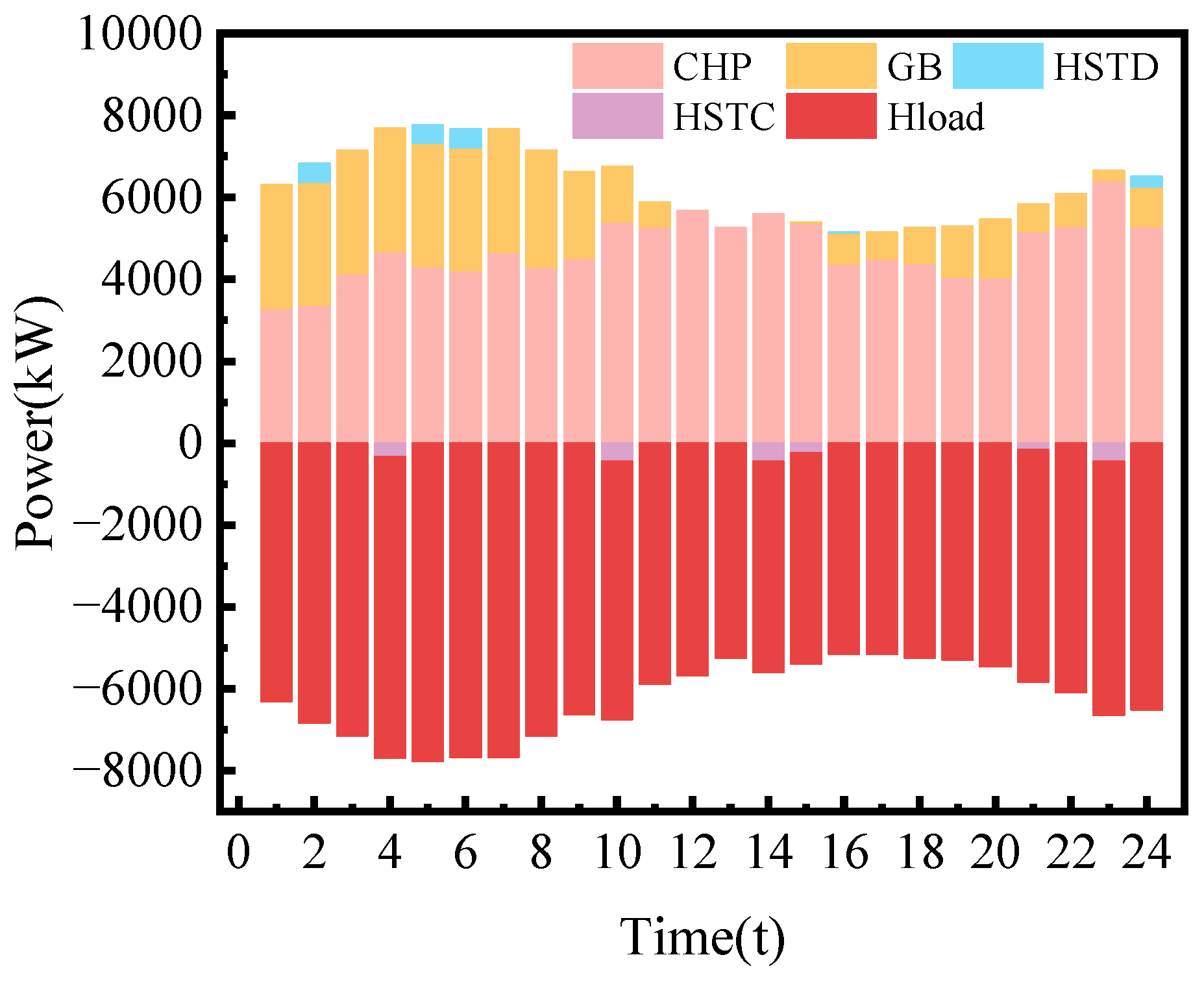
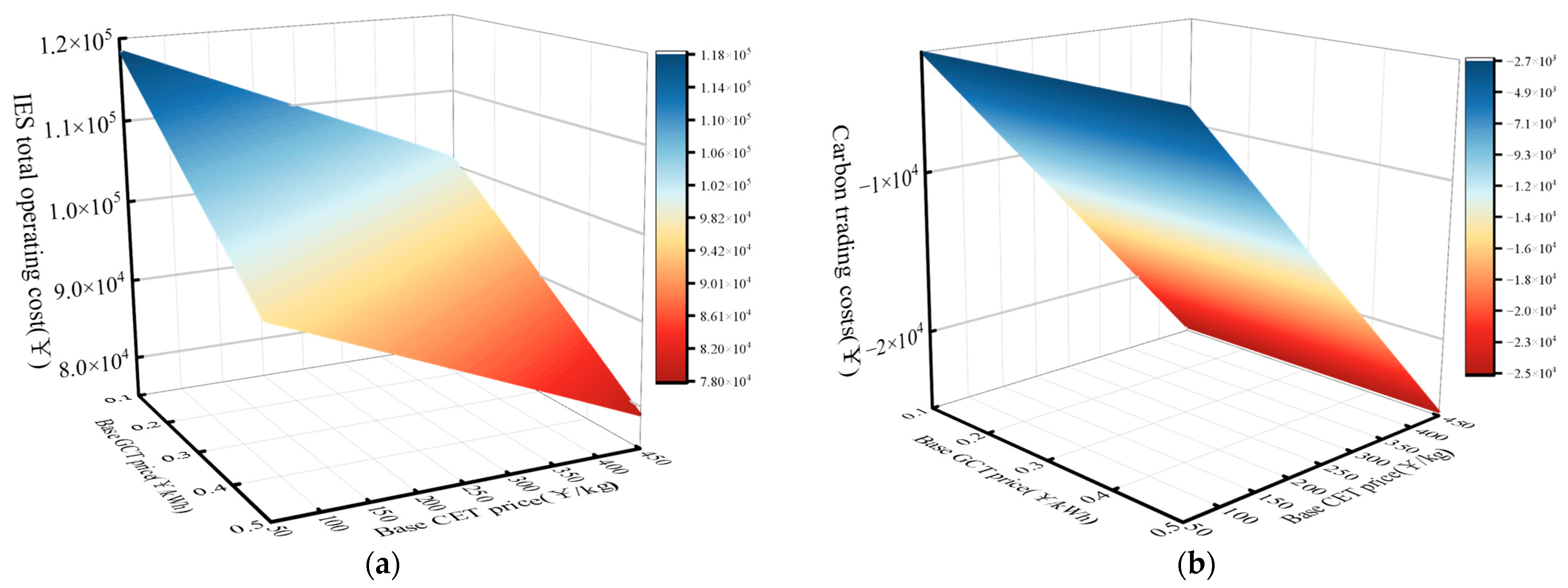
| Parametric | Value | Parametric | Value |
|---|---|---|---|
| (MW) | 1.2 | / [14] | 2/−2 |
| (m3) | 292/0 | (MW) | 3/0 |
| (m3) | 292/0 | (MW) | 0.75/−0.75 |
| (m3) | 146/146 | [21,23,48] | 0.9/0.95/0.98 |
| 0.9 | (MW) [21,23,48] | 0.45/−0.45 | |
| (kg/m3) | 1.964 | (MW) [21,23,48] | 0.45/0.45 |
| (J/kg) | 1.4 × 108 | (MW) [21,23,48] | 2.5/−2.5 |
| 0.85 | (MW) [21,23,48] | 1.8/3.6/10 | |
| (J/kg) | 5.071 × 107 | (t MWh) | 0.472 |
| (kg/m3) | 0.71428 | (t/MWh) | 0.7159 |
| 0.65 | (t/MWh) [14] | 0.2201 | |
| (MW) | 3.6/0 | (t/GJ) [14] | 0.0557 |
| 0.4/0.5 | (t/GJ) [3] | 0.0557 | |
| [3] | 0.69 | (CNY/t) | 50 |
| (MW) | 6/1.05 | (CNY/t) | 180/60 |
| (MW) | 2.5/−2.5 | (CNY/kWh) [14] | 0.6/0.6 |
| 0.35 | (CNY/kW) | 0.05/0.03/0.03 | |
| 0.3/0.5 | (CNY/kW) | 0.02/0.01 | |
| (MW) | 7.5/0 | (CNY/kW) | 0.02/0.02/0.02 |
| (MW) | 7.5/0 | (t) | 200 |
| (MW) | 2/−2 | 0.92 | |
| / [14] | 2.5/0 | / [14] | 0.5/−0.5 |
| Type | Period | Price | ||
|---|---|---|---|---|
| Electricity price | Peak period | 8:00~11:00 | 18:00~21:00 | 1.2104 (CNY/kWh) |
| Flat period | 6:00~7:00 | 12:00~17:00 | 0.6759 (CNY/kWh) | |
| Valley period | 1:00~5:00 | 22:00~24:00 | 0.4111 (CNY/kWh) | |
| Gas price | 24 h | 3.5 (CNY/m3) | ||
| Case | CCS | P2G | HYS | CCS-P2G | Ladder-Type CET | Ladder-Type GCT | “Green-Carbon” |
|---|---|---|---|---|---|---|---|
| 1 | ✖ | ✖ | ✖ | ✖ | ✔ | ✖ | ✖ |
| 2 | ✖ | ✔ | ✔ | ✖ | ✔ | ✖ | ✖ |
| 3 | ✖ | ✖ | ✖ | ✔ | ✔ | ✖ | ✖ |
| 4 | ✖ | ✖ | ✔ | ✔ | ✔ | ✖ | ✖ |
| 5 | ✖ | ✖ | ✔ | ✔ | ✔ | ✔ | ✖ |
| 6 | ✖ | ✖ | ✔ | ✔ | ✖ | ✖ | ✔ |
| Case 1 | Case 2 | Case 3 | Case 4 | Case 5 | Case 6 | |
|---|---|---|---|---|---|---|
| /CNY | 7649.4128 | 7475.8882 | 1878.4802 | 1526.8512 | 1526.8028 | −13,750 |
| /CNY | 18,571.436 | 17,732.8642 | 18,892.6861 | 18,456.0788 | 18,456.0788 | 19,825.4644 |
| /CNY | 10,0675.4279 | 95,412.8678 | 98,779.8244 | 97,705.694 | 97,705.694 | 95,458.7748 |
| /CNY | 25,619.4362 | 6105.0954 | 5766.603 | 2986.4 | 2986.4 | 2986.4 |
| Carbon Purchase Cost /CNY | 0 | 5087.2127 | 0 | 0 | 0 | 0 |
| /CNY | 6831.5929 | 7136.9476 | 7250.8423 | 7311.4341 | 7311.4341 | 7369.02 |
| /CNY | 159,347.3058 | 138,950.8759 | 132,568.4361 | 127,987.9559 | 121,389.3245 | 105,966.6922 |
| /kg | 93,214.2234 | 92,390.1214 | 76,449.9186 | 73,446.2553 | 73,446.2553 | 26,008.2817 |
| / | 0 | 0 | 0 | 0 | 6597.1332 | 5922.9671 |
| WT and PV Consumption Rate | 0.7644 | 0.9438 | 0.9470 | 0.9725 | 0.97253 | 0.97253 |
Disclaimer/Publisher’s Note: The statements, opinions and data contained in all publications are solely those of the individual author(s) and contributor(s) and not of MDPI and/or the editor(s). MDPI and/or the editor(s) disclaim responsibility for any injury to people or property resulting from any ideas, methods, instructions or products referred to in the content. |
© 2025 by the authors. Licensee MDPI, Basel, Switzerland. This article is an open access article distributed under the terms and conditions of the Creative Commons Attribution (CC BY) license (https://creativecommons.org/licenses/by/4.0/).
Share and Cite
Huang, X.; Zhong, J.; Xiao, M.; Zhu, Y.; Zheng, H.; Zheng, B. Optimal and Sustainable Scheduling of Integrated Energy System Coupled with CCS-P2G and Waste-to-Energy Under the “Green-Carbon” Offset Mechanism. Sustainability 2025, 17, 4873. https://doi.org/10.3390/su17114873
Huang X, Zhong J, Xiao M, Zhu Y, Zheng H, Zheng B. Optimal and Sustainable Scheduling of Integrated Energy System Coupled with CCS-P2G and Waste-to-Energy Under the “Green-Carbon” Offset Mechanism. Sustainability. 2025; 17(11):4873. https://doi.org/10.3390/su17114873
Chicago/Turabian StyleHuang, Xin, Junjie Zhong, Maner Xiao, Yuhui Zhu, Haojie Zheng, and Bensheng Zheng. 2025. "Optimal and Sustainable Scheduling of Integrated Energy System Coupled with CCS-P2G and Waste-to-Energy Under the “Green-Carbon” Offset Mechanism" Sustainability 17, no. 11: 4873. https://doi.org/10.3390/su17114873
APA StyleHuang, X., Zhong, J., Xiao, M., Zhu, Y., Zheng, H., & Zheng, B. (2025). Optimal and Sustainable Scheduling of Integrated Energy System Coupled with CCS-P2G and Waste-to-Energy Under the “Green-Carbon” Offset Mechanism. Sustainability, 17(11), 4873. https://doi.org/10.3390/su17114873







